In winter, the human body is usually weakened. For the immune system to work at full capacity, it needs to be strengthened. The intake of vitamins enhances immunity, the body copes better with protection against viruses and colds. Most often, in the cold season, doctors recommend eating as many fruits as possible. After all, natural vitamins are not only healthier than purchased, but also much tastier.
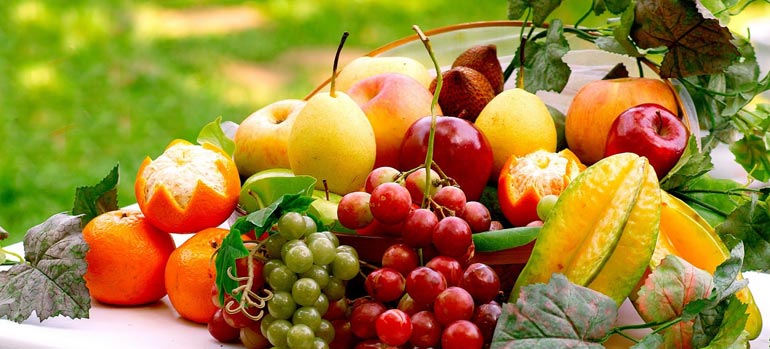
However, do not forget that fruits (as well as vegetables) are most useful in the season. Strawberries and plums, for example, will bring our body much more vitamins in the summer. Of course, they can be found in stores in the winter, but when growing summer fruits and berries in the cold season, they use a huge amount of fertilizing and fertilizers, which means that the benefits of such “vitamins” become minimal. But there are also fruits whose usefulness increases precisely in the winter.
Pineapples
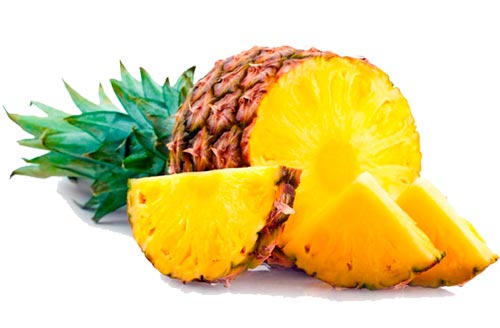
To enjoy the most ripe and delicious pineapples, you need to be able to choose them correctly. As a rule, these fruits are brought to our country unripe, and this affects their taste. When choosing a pineapple, you should pay attention to its color: a ripe and sweet fruit has an even yellow color, there should not be any dirty spots on it.
Benefit
Pineapples are rich in vitamins C and PP, contain a lot of B vitamins, and also have many useful minerals, such as phosphorus, potassium, calcium and magnesium. Pineapple fruits are known to have a positive effect on intestinal motility. But rumors that pineapple juice is able to break down fats have not yet been confirmed, so do not count on miraculous weight loss with these exotic fruits.
Pineapples can be consumed during pregnancy, of course, if a woman does not have an allergic reaction to them. But they should not be abused - once or twice a week will be enough.
Pineapples are not recommended for children under three years of age, they can cause irritation of the gastric membrane and severe allergies.
If we talk about the nutrition of children, then fresh pineapple is better to prefer canned - it is better absorbed. But the child is better not to give pineapple syrup - it contains a lot of sugar.
Oranges

The most beloved by the Russian people citrus fruits come from Latin America and the Mediterranean.One of the most popular varieties of oranges is called “Navel”, which means “navel” in English. The fruits of this variety have a thick but easily detachable peel, and at the top there is a small round process, similar to a navel. In fact, this process is an underdeveloped second fetus. It is believed that the larger it is, the sweeter the orange.
Sicilian oranges are no less popular. Their peel and pulp have an unusual color, mainly red and brown. For this feature, Sicilian oranges are popularly called "bloody".
Benefit
Oranges, like pineapples, are rich in potassium, phosphorus, magnesium, calcium and vitamin B. And oranges are simply champions in the content of vitamin C.
Oranges (and orange juice) can be given to children, but do not forget about caution - these citrus fruits are quite allergenic, and the acids they contain can cause mucosal irritation and lead to gastritis.
Women during pregnancy can also eat oranges, but in small quantities and not daily. In small doses, oranges have a positive effect on intestinal motility and help to avoid constipation, often accompanying pregnancy.
After eating oranges (and other citrus fruits), it is recommended that you rinse your mouth thoroughly. This simple action will help protect tooth enamel from decay.
Grenades
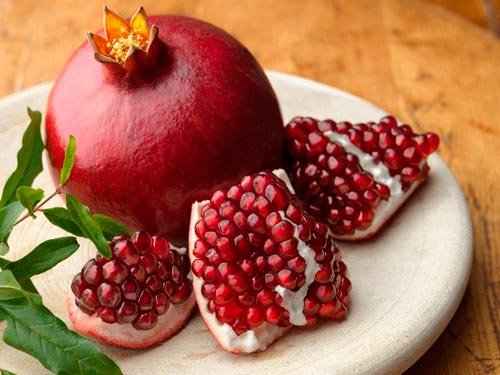
Bright red pomegranate fruits grow mainly in the Middle Eastern countries, as well as in Greece, Spain, Italy and some Caucasian countries. Pomegranates are large berries with juicy seeds inside.
When buying pomegranates should pay attention to their peel. It should be a little dry. Depending on the variety, the color of ripe pomegranate varies from pale orange to burgundy.
Benefit
Pomegranate fruits contain vitamins PP, B and C, and are also rich in trace elements: iron, iodine, magnesium, potassium and phosphorus. Pomegranates perfectly raise hemoglobin, so their use during pregnancy will help to avoid problems associated with anemia.
Pomegranates have a beneficial effect on the nervous system, help fight gum disease and increase appetite.
Children under two to three years old are not recommended to give pomegranates to the sample. Familiarity with these fruits is best to start with juice diluted with water, for the first time a small spoon will be enough. If the next day the child does not have an allergy, then you can go directly to the grains.
Do not forget - pomegranates have a fixing effect, therefore it is not advisable to use them for people prone to constipation.
Grapefruits
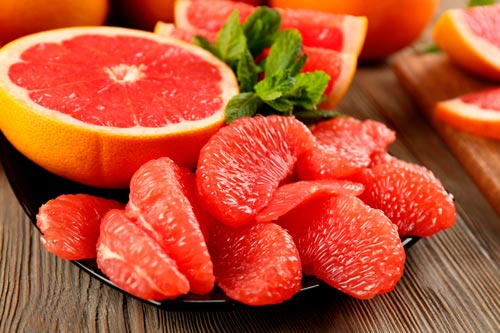
Grapefruits grow mainly in South African countries and in Israel. The taste of grapefruit is bitter-sour, it differs noticeably from the taste of other citrus fruits. Varieties with a peel of red color are considered sweeter, less sweet - with a peel of yellow and green colors.
Benefit
Grapefruits are rich in vitamins A, B, E and, of course, C. They also contain potassium and calcium.
Eating grapefruit has a good effect on the digestive system. Grapefruit fruits have a mild laxative effect, so they are often recommended for constipation during pregnancy.
Grapefruits well strengthen blood vessels, and therefore they are useful for people suffering from bleeding gums. And they significantly improve mood.
Grapefruits can be consumed by children from three years. But kids usually don't like the bitter taste of these citrus fruits, so they prefer oranges or tangerines.
Figs
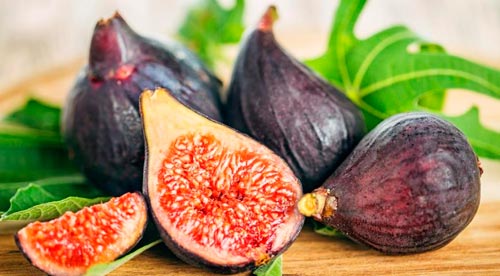
Figs - a representative of one of the ancient cultures grown in the Mediterranean, in the Crimea and the Krasnodar Territory. Fresh fig berries are stored for a very short time - approximately 7-10 hours, so they are usually consumed in dried form.
Benefit
Fresh and dried figs are quite different from each other in the number of useful trace elements contained in them.Vitamins C and B5 predominate in fresh fruits, and vitamins PP, B1, B2 and E prevail in dried fruits. Folic acid, magnesium, potassium, sodium, phosphorus and iron are also found in figs.
Fig berries are good for digestion. During pregnancy, the use of figs helps prevent anemia. However, if the expectant mother notices a sharp jump in weight, then it is recommended to reduce the amount of dried figs consumed or to prefer less caloric fresh fruits.
Figs are also good for children. They have a good effect on children's digestion and gastric motility.
Kiwi
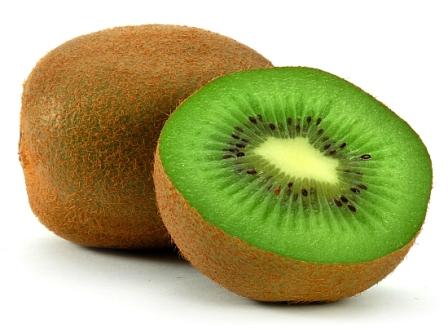
Kiwi fruits have a brown hairy skin and bright green flesh. They have a very low calorie content, and therefore are quite popular in diet food. Different people describe the taste qualities of kiwi in different ways: someone believes that their taste resembles strawberry, others compare them with a mixture of tastes of gooseberries, banana and strawberries.
Benefit
The most important vitamin that kiwi contains is Vitamin C. However, besides it, kiwi fruits are rich in B vitamins, magnesium, phosphorus, potassium and calcium.
The use of kiwi during pregnancy will help to avoid constipation and will have a beneficial effect on intestinal motility.
Kiwi fruits can cause severe allergies, and therefore they are not recommended for children under three years of age. You can give kiwi to older children, but in a small amount and not more often 1-2 times a week.
Tangerines
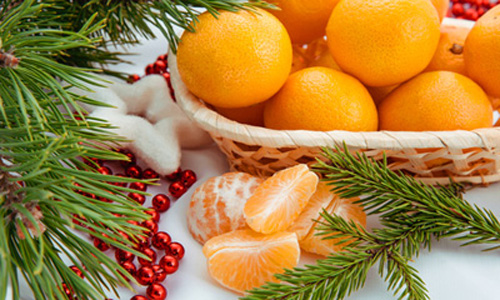
Tangerines in Russia are closely associated with the celebration of the New Year. Small orange citrus fruits come to us from Spain, Morocco, China, Turkey and Egypt. In winter, on the shelves of shops you can find tangerines from Azerbaijan and Abkhazia - they may not be as sweet as their overseas comrades, but, of course, very fragrant.
Mandarins are outwardly similar to clementines (hybrids of mandarin and orange), so people often confuse them. Outwardly, these citrus fruits differ only in shape: clementines are more rounded, while tangerines are usually slightly flattened. If we talk about differences in taste, then clementines, as a rule, are much sweeter than tangerines.
Benefit
Mandarins are primarily vitamins A, B, C, K and many useful trace elements, such as potassium, calcium, magnesium, phosphorus and sodium.
Mandarins have a positive effect on digestion and appetite. But despite this, getting fat from them is impossible, of course, if you do not bite them with high-calorie buns.
For pregnant women, tangerines are useful for constipation, children should not eat them in large quantities, since allergy is possible.
Pitahaya
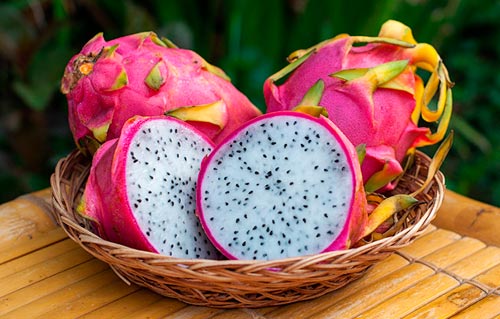
This bright exotic fruit is exported to Russia mainly from Asian countries such as China, Vietnam, Malaysia and Sri Lanka. In fact, pitahayas are the fruits of a cactus growing in the subtropics. In our country, pitahaya fruits with a pink-red peel are common, less common with yellow and they usually have a more pronounced sweet taste. The pitahaya pulp is white with a large content of small edible seeds of black color.
Benefit
Pitahaya fruits are watery, their pulp contains almost no calories. Pitahaya contain vitamins C and B, and are also rich in phosphorus and potassium. They positively affect the work of the stomach, intestines and cardiovascular system.
Due to the high risk of allergies, eating pitahaya during pregnancy should be reduced to a minimum. The same goes for children - pitahaya can cause hives and stomach problems in babies.
Pomelo

The largest member of the citrus family. The fruits of the pomelo have a pronounced sweet and sour taste and a thick, easily detachable peel. Pomelo pulp, unlike other citrus fruits, does not have a special juiciness.
When buying a pomelo, it is worth paying attention to the color of the fruit - it should be uniform. If the fruit is painted in several colors - then it is immature.
Pomelo fruits can be stored for a long time. Only pulp can be eaten, without peel and membranes.
The Chinese believe that pomelo is a symbol of stability, wealth and prosperity. That is why in China there is a tradition - to give fruits pomelo friends and relatives for the New Year.
Benefit
Pomelo contains a large amount of vitamin C, B vitamins, as well as beta-carotene, calcium, potassium and phosphorus. According to nutritionists, pomelo fruits significantly accelerate metabolism, which makes this fruit very popular for those who want to lose extra pounds.
Eating pomelo during pregnancy contributes to a better development of the baby's skeletal system. For children, the pomelo is also useful and can be a useful alternative to cakes and cookies for afternoon tea.
Persimmon

Bright orange fruits appear in our stores in late October or early November. Persimmons are imported into our country from the Caucasus, as well as from Israel, Spain and China. Only fully ripened fruits are suitable for eating, otherwise they will be very viscous to the taste.
When buying persimmons, it is necessary to give preference to softer fruits with brown leaves. If persimmon is hard, and its leaves are green, then it is clearly unripe.
Benefit
Such persimmons are dominated by vitamins such as A, C, and E, as well as beneficial trace elements: iron, magnesium, phosphorus, potassium, and iodine.
When using persimmons, it is important to be careful and not to forget about two important things. First, these fruits are very sweet, the calorie content of certain varieties of persimmon can exceed 100 kcal per 100 grams, while the average fruit weight is 250-300 grams.
And secondly, persimmon contains fibers with tannins (they protect fruits from diseases and it is due to them that persimmon has a memorable astringent taste). Our stomach cannot digest such fibers, therefore, with a large consumption of persimmon fruits (especially immature), a bezoar is formed inside it - a dense foreign body that is not digested and is difficult to be excreted from the body or not excreted independently at all, then it is removed from the body by surgical intervention.
To avoid problems, persimmons are not recommended to be consumed in large quantities (more than one or two fruits per day). This is especially true for people with impaired intestinal motility, suffering from constipation and bloating. Since during pregnancy these symptoms occur quite often, the use of persimmons should be treated with caution.
In moderate amounts, persimmon can be offered to a child. This should be done no more than once a day and no more than one small fruit at a time (or half large).
Persimmons can be frozen and then the amount of tannins in it will decrease, but not everyone will like the excessively soft texture of thawed fruit.
Useful video: How to keep vegetables and fruits to eat healthy all winter









I would add to this list of mangoes, avocados and papaya, who have the opportunity to buy these exotic fruits in winter. First of all, these fruits go to the child with a bang as a complementary food, and secondly, they are simply a storehouse of useful vitamins and minerals and very well increase immunity weakened in winter and during pregnancy.
It is very difficult to feed our five year old child fruit. Remove the skins, cut them in different figures, string them on toothpicks, mix them into another meal. The only thing is that it is possible to feed a small piece of ice cream without problems, pouring it with grated chocolate or making fruit puree and freeze in a mold. The only favorite fruit is pomegranate.
It is better not to get carried away with citrus fruits during pregnancy, an allergy may appear in the baby after birth, and I came across this. And in order not to get sick in the winter and replenish the body with vitamin C, it is better to eat kiwi or pomegranate.